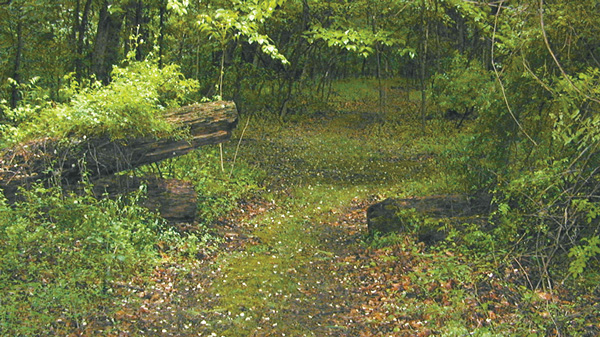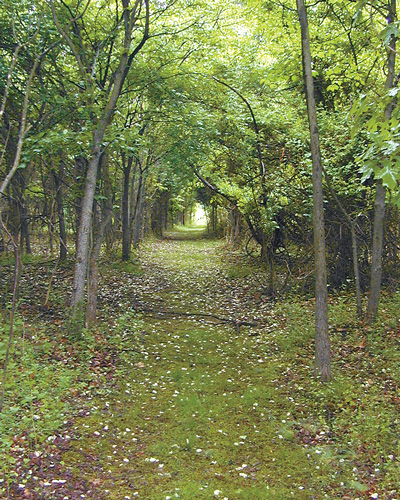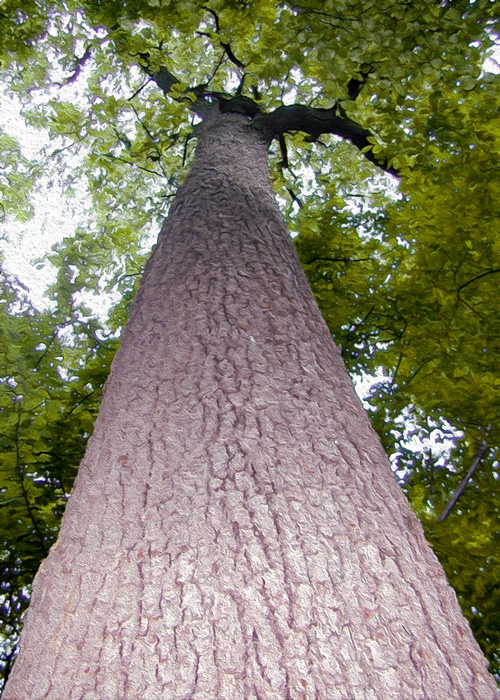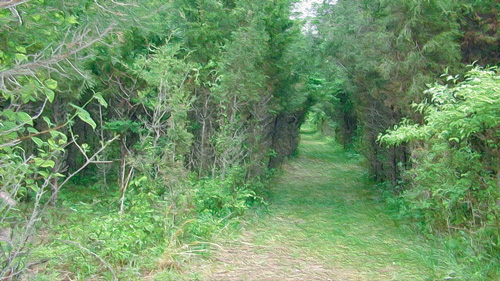Hutcheson Memorial Forest, a 65-acre tract of old growth forest in Franklin Township, Somerset County, is a conundrum in time and purpose. It lays in limbo between a no-management policy mandated to preserve the forest's character, and influences brought by suburbia that force change. The forest is one of only three patches of virgin woods remaining in New Jersey, and one of the last uncut, unburned White Oak--American Beech forests in the country. It is listed in the National Park Service Registry of Natural landmarks.

The forest, also called Mettler's Woods, is part of a 525-acre parcel of land owned by Rutgers University that is comprised of abandoned farm fields, young forest, ecology research plots and farmland.
In the 1700s, the forest was bought by Dutch settlers and has since been owned by their descendents, the Mettler family. In the 1950s, core samples taken on old oaks and beech knocked down by a hurricane showed that many of the trees were over 350 years old. Impressed by timber quality, a logging company offered to purchase the woods, but in 1955, the Citizen's Committee for the Preservation of Mettler's Woods and the United Brotherhood of Carpenters and Joiners purchased the 150-acre property that included the woods and donated it to Rutgers. In exchange they ordered that the deed contain two conditions: 1) there would be a "no management" policy in the old growth forest, with only one trail allowed to be kept open, and 2) the forest would be named after one of the union's dead presidents.
Hutcheson Memorial Forest was born, and has been maintained in a natural state--protected from fire, and all blowdowns left where they fall.
These conditions are strictly respected, but the forest's director, Dr. Edmund Stiles, is concerned about the inadvertent "management" caused by the surrounding land use. He is concerned that if houses are built adjacent to the forest, it will not be able to maintain itself.
Since much of the forest is lowland traversed by the Spooky Brook, by topography and definition the nearby farms are upslope. Their heavy equipment causes erosion that buries small plants and seeds that are necessary for forest species regeneration. On a silt-covered slope, where there was once a myriad of wild flowers, there is now a monoculture of garlic mustard. Agricultural nitrates and phosphates wash down-slope through the forest in high concentrations, and cause algae blooms that lower oxygen in the soil, killing plants, fish and forest critters. They also change what grows.
From the coring after the hurricane, ecologists discovered that eleven-year fires were part of the life cycle of this primal patch of woods prior to 1700. The fires were probably set by American Indians to promote the growth of understory shrubs by opening up the canopy. Fire is not allowed in the forest now, so standing trees form a dense canopy prohibiting the growth of species that require sun. There are fewer oaks now, and more red maple, which grows almost anywhere.
Increased housing along the forest's perimeter has caused an increase in deer population. On this walk through the woods with caretakers Loius Cantafio and Jamie Scott, this writer saw at least four small groups of deer at close range. The deer find young, regenerating native plants more palatable than invasive species. Invasives like Japanese honeysuckle, multiflora rose and Japanese barberry are gaining a foothold and displacing native shrubs and seedlings.
"So, with our attempts not to manage, we are causing the change," says Cantafio.
But positive "management" works from outside the forest as Rutgers adds more open space to buffer the primal forest. The additional land also provides green corridors to other open spaces, allowing the migration of deer, box turtles and other wildlife between havens. The preserve bordering Mettler's Woods now totals over 525 acres.
In the late 1980s, Dr. Stiles was instrumental in the re-zoning of housing lot sizes from six acres to three-quarter acre lots. When this allowed a local farmer to make more money by building more houses, he donated half his acreage to Rutgers. Other pieces of land that buffer the forest were acquired with grant and Green Acres money. Working partnerships with Franklin Township and The Nature Conservancy also aid in the university's conservation efforts.

On this walk, we pass the abandoned farm fields--sites of the country's longest running "Forest Succession" studies begun in 1958. I admire the low, thick limbs of a white oak that jut out over the trail ahead. Cantafio tells me that white oak is the only tree species able to grow heavy horizontal limbs because resin fills the old vascular tissue, providing structure and support. He says that's why it's used for wine barrels. I notice that the other canopy trees have branches that grow straight up, from high up on their trunks.
Most of the old trees in the woods are dying. Cantafio explains that "Natural Selection" for trees does not include longevity--there's not much reason for a tree species to evolve to live past a few hundred years. They usually die by fire or blowdown anyway. He points to a recent casualty, another old tree, windthrown and laying in the lowland, shallow roots exposed in death.
I feel sadness walking through this old patch of woods, so precious its preservation was written in stone. The demand that it remains "preserved"--untouched--is promoting its decline. In its state of flux over time, the rules that vow to protect it will likely destroy it. The caretakers tell me that 20 or 30 years ago, the forest was more open to the sun. It had lots of dogwood then, and now, instead, it has lots of barberry.
"The policy of 'non-management' is really management that inadvertently changes the forest, although we try not to," says Cantafio.
But there are still treasures to behold in this primal forest--regeneration of elephant-skinned American beech by root sprouts. Nearby smaller trees may in fact be part of the same organism, grown up from a long umbilical root connecting them underground. I see in the muddy lowland, big bird tracks, some with a long stroke after them, followed by the fingers of wings--wild turkey taking off!

Along the skinny footpath, there are tall slim trees of persimmon with black alligator bark, black cherry, black oak, and pin and red oaks. Maples are abundant--red, silver, sugar and Norwegian, and the wild grape grows everywhere.
Every year a complete inventory of the forest's fungi is taken. Yearly bird population studies show that there are now a lot fewer songbirds in the forest than before--maybe due to cowbirds that remove eggs from songbird nests and deposit their own. They live on the edges of woodlands, and almost all forests in the state are "edges"--another good reason to buffer the forest. There are great horned owls and red-tailed hawks, northern harriers, coopers hawk and the sharp-shinned. It was here on a tour led by an ornithologist that I once held a yellow-throated sparrow in my hands.
"The primary function of the property is preservation of an old-growth forest and open space in general. But it's also a research facility, and anyone interested in doing outdoor research is welcome here," said Cantafio. There is an aviary that allows people to work with birds in their native environment, natural temperatures and cycles.

Much of the forest is wet due to the geology in the middle where the soil is sandy. Under a gap in the canopy, greenbriar grows abundantly, and along the muddy sides of the stream, skunk cabbage flourishes. Its metabolic heat can melt snow and helps the release of odorous compounds in the flowers in order to attract pollinators, once the temperature reaches 54 - 56° . The Spooky Brook drains the area and one can cross the brook on an ecologically-correct plastic-wood plank with big chunks removed by teeth-grinding squirrels.
In summer, the forest looks much like a garden. The fields are covered with wildflowers and the air is filled with bird song. The huge Eastern red cedars have the look of junipers planted in old English gardens. Paths along the edges are covered in moss, perfect for a wild garden.
Not much goes unnoticed on the property, like the nest of honeybees that moved into the base of the wooden arch over the entrance drive. True to non-management policy, Cantafio said, "We thought long and hard about it, and we decided to let them stay."
The forest is open to the public during the regularly
scheduled tours given on Sundays throughout the year. These tours,
led by Rutgers University faculty who volunteer their time, take from
about an hour to two hours. Depending on the expertise of
the tour leader, the interest of the group, and what is flowering,
flying, calling or crawling, various aspects of natural history, forest
ecology, conservation issues and ecological relationships are pointed
out and discussed. Check the website for upcoming schedules.
Dedicated to preserving the heritage and history of the railroads of New Jersey through the restoration, preservation, interpretation and operation of historic railroad equipment and artifacts, the museum is open Sundays, April thru October.
The Jacobus Vanderveer house is the only surviving building associated with the Pluckemin encampment.
The Millstone Scenic Byway includes eight historic districts along the D&R Canal, an oasis of preserved land, outdoor recreation areas in southern Somerset County
Even today, if you needed a natural hideout—a really good one—Jonathan’s Woods could work.
Paths of green, fields of gold!